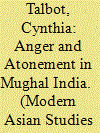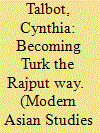| Srl | Item |
| 1 |
ID:
179916


|
|
|
|
|
| Summary/Abstract |
Anger as an emotion is seldom attributed to Akbar (r. 1556–1605), the most admired of the Mughal emperors. Yet, on one notable day in 1578, he allegedly got so enraged that he almost lost his mind, according to Dalpat Vilas, an obscure chronicle composed in the vernacular. While the aftermath of Akbar's anger was reported in several Persian histories emanating from court circles, the royal rage itself was not. Why and how Dalpat Vilas ascribed anger, not only to the emperor but also to the local king, Raja Ray Singh of Bikaner, is the central issue addressed here. What little we know about the history of anger in precolonial India indicates it was an emotion that kings were advised to avoid, in both Sanskrit and Persian literature. But, from the more subaltern vantage point of Dalpat Vilas, written for a young Rajput warrior in a local dialect, rulers did act angrily and not always justly. This case illustrates the historiographic value of Indic-language texts sponsored by local subordinates of the Mughals, which can provide alternative perspectives on the empire. It also suggests the existence of multiple emotional communities in Mughal India, in which the significance of anger differed.
|
|
|
|
|
|
|
|
|
|
|
|
|
|
|
|
| 2 |
ID:
089362


|
|
|
|
|
| Publication |
2009.
|
| Summary/Abstract |
The Kyamkhanis were a small Indian Muslim community who flourished in northern Rajasthan from c. 1450 to 1730. This article examines memories of the Kyamkhani past recorded in a seventeenth-century history of the ruling lineage, as a case study of both the process of Islamic expansionism in South Asia and the self-identity of rural Muslim gentry. While celebrating the ancestor who had converted to Islam generations earlier, the Kyamkhanis also represented themselves as local warriors of the Rajput class, an affiliation that is considered exclusively Hindu in India today. Their history was written in a local literary language, Braj Bhasa, rather than in the more cosmopolitan Persian that was widely used by Muslim elites at the time. The Kyamkhanis of the early modern era thus negotiated multiple social and cultural spheres, simultaneously participating in the local/vernacular as well as global/cosmopolitan arenas.
|
|
|
|
|
|
|
|
|
|
|
|
|
|
|
|